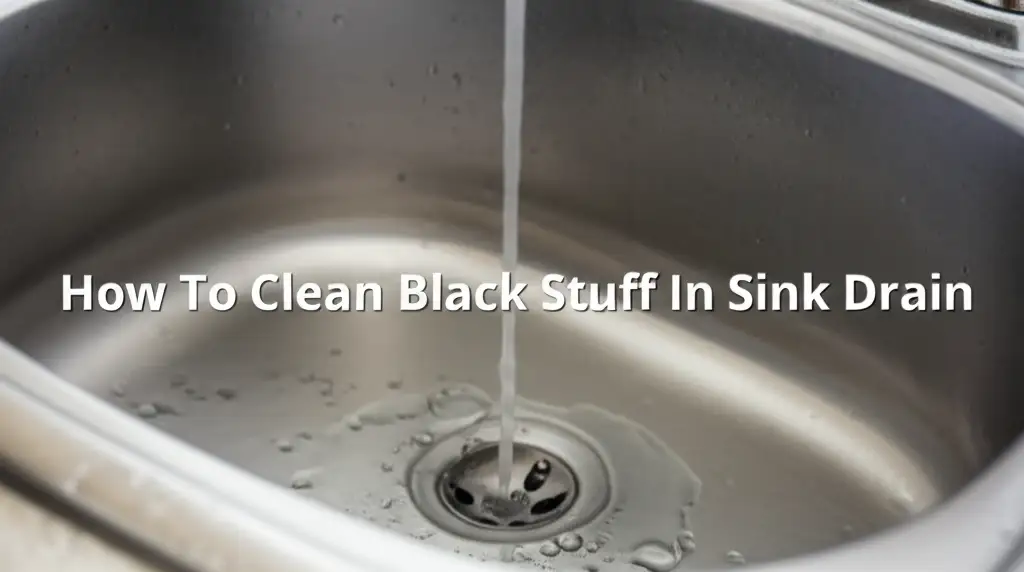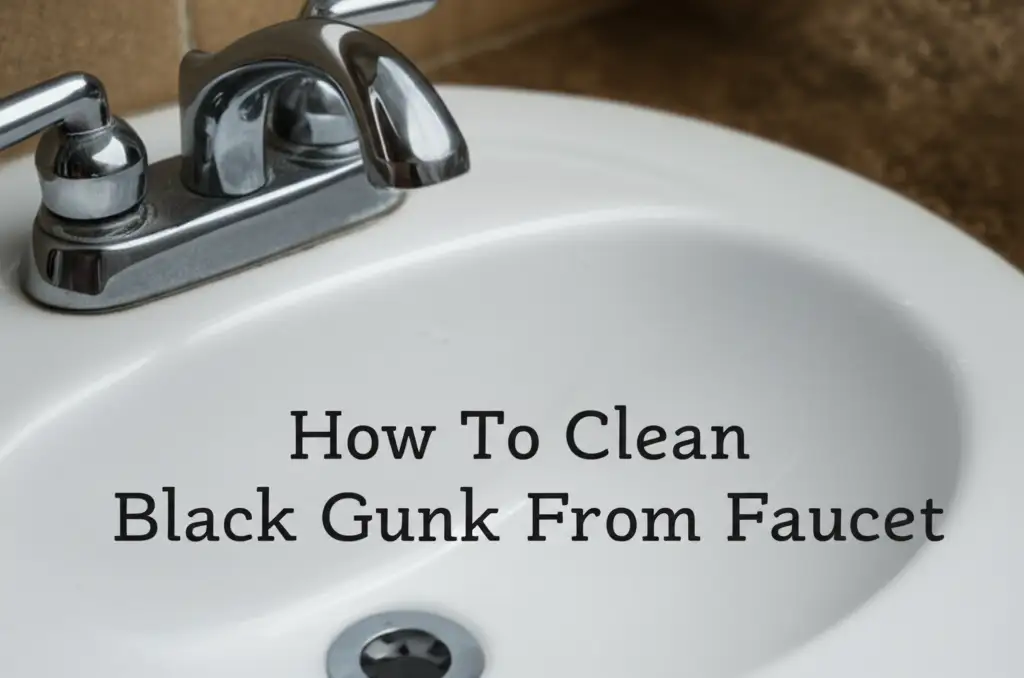· Home Cleaning · 19 min read
How To Clean Black Stuff In Sink Drain

Easy Ways to Clean Black Stuff in Your Sink Drain
Have you ever noticed that unsightly black stuff creeping out of your sink drain? It can be a real nuisance. This slimy buildup often comes with a unpleasant smell. I know how frustrating it is to deal with a drain that looks dirty and smells bad.
This article gives you the knowledge to handle this common household problem. You will learn what causes the black stuff. I will show you how to clean black stuff in sink drain effectively. We will look at simple home remedies, mechanical tools, and when to use stronger cleaners. We also cover ways to prevent it from coming back. Get ready to have a cleaner, fresher sink drain.
Takeaway
- Identify the source of black drain gunk (biofilm, mold, debris).
- Use natural solutions like baking soda and vinegar for mild clogs.
- Employ mechanical tools like plungers or drain snakes for stubborn buildup.
- Apply commercial drain cleaners cautiously when other methods fail.
- Practice regular maintenance to prevent future black stuff accumulation.
You can clean black stuff in your sink drain using a mix of natural cleaners like baking soda and vinegar, followed by hot water. For more stubborn clogs, a drain snake or plunger can remove physical blockages. Regular cleaning prevents future buildup.
Understanding the Black Stuff: What It Is and Why It Forms
That black, slimy substance you see in your sink drain is often a biofilm. A biofilm is a collection of bacteria, mold, and other microorganisms. They grow in damp, dark places. Your sink drain offers the perfect environment for these organisms to thrive. They feed on soap scum, grease, food particles, and hair.
The black color comes from certain types of bacteria and mold. These organisms often produce dark pigments. As they multiply, they form a visible layer. This layer can be slimy or gel-like. It sticks to the inside of your drain pipes. Over time, this buildup can also cause slow drainage and unpleasant odors. It is a common problem in both kitchen and bathroom sinks. Knowing what causes it helps you clean it better.
Common Culprits Behind Black Drain Slime
Several things contribute to the formation of black gunk in your sink. First, human hair is a major factor, especially in bathroom sinks. Hair traps soap scum and dead skin cells. This creates a sticky mess where bacteria can attach. For more tips on removing hair, you can check out this guide on how to clean hair out of bathroom sink drain.
Second, food particles and grease are common culprits in kitchen sinks. Small bits of food can get washed down the drain. Grease solidifies as it cools. This sticky residue acts as food and a lodging point for bacteria and mold. Even small amounts build up over time.
Third, soap scum from shampoos, conditioners, and body washes also plays a role. These products leave behind a film inside pipes. This film creates an ideal surface for microorganisms to grow. Combined, these elements create the perfect breeding ground for the black slime. Addressing these sources is key to a clean drain.
Gathering Your Tools: Essential Supplies for Drain Cleaning
Before you start cleaning, gather the right tools. Having everything ready makes the job easier and faster. You might not need every item for every clean. However, it is good to have them on hand. This ensures you are prepared for any level of black stuff buildup.
Start with basic household items. You will need baking soda and white vinegar for natural solutions. A large pot to boil water is also essential. For more direct removal, a plunger can create pressure to dislodge clogs. A drain snake, also called a plumber’s snake or auger, is useful for reaching deeper blockages.
Consider protective gear too. Rubber gloves protect your hands from grime and cleaning chemicals. Old towels or rags are great for wiping up spills. A bucket can catch dirty water if you decide to open the P-trap. These supplies help you tackle the problem safely and effectively.
Basic Household Items for Cleaning
You likely have many effective cleaning agents already in your pantry. Baking soda and white vinegar are a powerful combination. They create a fizzy reaction that helps break down organic matter. This makes them excellent for general drain maintenance. You can learn more about using them together here: how to clean with vinegar and baking soda.
Dish soap is another handy item. It can help cut through grease buildup. Hot water is crucial for flushing out loosened debris. It helps melt fats and oils. Salt can also be mixed with baking soda to add abrasive power.
These items are safe for most pipes and the environment. They are a great first step for mild clogs and odors. You can often clean black stuff in sink drain without harsh chemicals using these simple ingredients. Always try these methods before moving to stronger solutions. They are effective and gentle.
Mechanical Tools for Stubborn Clogs
Sometimes, black stuff and other debris create a stubborn clog. Natural solutions might not be enough. This is when mechanical tools come in handy. A plunger is the most common tool. It uses suction to dislodge blockages. Make sure the plunger covers the drain opening completely. Fill the sink with a few inches of water to create a good seal.
For deeper clogs, a drain snake is invaluable. This long, flexible tool can reach into the drain pipe. It can grab or break up the black gunk and other obstructions. You feed the snake into the drain until it hits the blockage. Then, you twist it to break up or pull out the debris.
Remember to be gentle when using a drain snake. Too much force can damage pipes. You can also damage the drain stopper or other internal components. These tools are often available at hardware stores. They are a worthwhile investment for drain maintenance.
Natural Remedies: Cleaning Black Gunk with Household Items
Using natural remedies is a great first step for cleaning your sink drain. They are safe for your pipes and the environment. These methods work best for mild to moderate black gunk buildup. They are also good for regular maintenance. I often start here before trying anything stronger.
The most popular natural method uses baking soda and vinegar. This combination creates a chemical reaction. The fizzing action helps loosen the grime and black stuff stuck to your pipes. It also helps neutralize odors. This method is simple to do.
Another effective natural approach involves using boiling water. Hot water can melt grease and help flush away loose debris. It is a good follow-up step after using other cleaners. Always be careful when handling boiling water. These natural solutions are often enough to keep your drains clear and clean.
Baking Soda and Vinegar Method
This is my go-to method for a grimy drain. First, pour half a cup of baking soda directly down the drain. Make sure as much as possible goes down the pipe. Next, follow with half a cup of white vinegar. You will hear a fizzing sound almost immediately. This fizzing action helps break down the black gunk.
Let the mixture sit in the drain for 30 minutes to an hour. Some people even let it sit overnight for tough clogs. The longer it sits, the more time it has to work. After waiting, flush the drain with a kettle full of boiling water. The hot water helps rinse away the loosened black stuff and other debris.
You may need to repeat this process if the black stuff is very heavy. This method is effective for maintaining clear drains. It is also safe for most types of plumbing. It’s an excellent way to clean black stuff in sink drain without harsh chemicals.
Salt, Baking Soda, and Hot Water Solution
This method adds a bit more abrasive power to the natural cleaning process. Start by mixing half a cup of salt with half a cup of baking soda. Pour this mixture slowly down the sink drain. The salt acts as a scrubbing agent, helping to dislodge sticky grime.
Let the salt and baking soda mixture sit in the drain for about 15-30 minutes. This gives it time to absorb some moisture and start working on the black gunk. After the waiting period, slowly pour a kettle of boiling water down the drain. Be careful not to splash yourself. The hot water will dissolve the mixture and help flush away the loosened black stuff and any grease buildup.
This combination is particularly good for kitchen sinks where grease can be a major issue. The salt helps scrape away the greasy film. The baking soda neutralizes odors. The hot water carries everything away. It is another great natural way to clean black stuff in sink drain effectively.
Mechanical Methods: Tackling Stubborn Drain Buildup
Sometimes, the black stuff in your drain is part of a larger blockage. It could be hair, grease, or other debris. Natural remedies might not be enough to clear these stubborn clogs. This is when mechanical tools become necessary. These tools help physically remove the obstruction.
Using mechanical methods can be a bit more hands-on. However, they are often very effective. They can save you from having to call a plumber for simple clogs. Always be careful when using these tools. Misuse can damage your pipes.
You will typically use a plunger or a drain snake. Both tools serve different purposes. They are great for getting deep into the drain to break up or pull out tough black gunk. I find them indispensable for keeping drains flowing freely.
Using a Plunger Effectively
A plunger is a simple yet powerful tool for clearing drain blockages. To use it correctly, first, remove any drain stoppers or strainers from the sink. Next, fill the sink with enough water to cover the rubber cup of the plunger. This helps create a good seal.
Place the plunger firmly over the drain opening. Ensure there are no gaps where air can escape. Begin to pump the plunger up and down vigorously. Do this 10-20 times. The plunging action creates pressure changes in the pipe. These changes help to dislodge the black gunk and any other debris.
After several plunges, quickly pull the plunger up to break the seal. Watch to see if the water drains. If it drains slowly, repeat the process. This method often works well for blockages near the drain opening. It’s a quick and easy way to try and clean black stuff in sink drain.
Operating a Drain Snake (Auger)
When a plunger does not work, a drain snake is often the next step. This tool is designed to reach deeper into the pipe. It can break apart or retrieve stubborn clogs. Start by feeding the snake’s cable into the drain opening. Push it slowly until you feel resistance.
When you hit the blockage, turn the handle of the snake. This action helps the tip of the snake grab onto or break up the black stuff, hair, or other debris. If you feel it grab something, pull the snake back slowly. You might pull out a nasty clump of black gunk and hair. This is why it’s important to wear gloves. For more specifics on clearing gunk, see this article on how to clean gunk out of bathroom sink drain.
Continue feeding, twisting, and pulling until the drain is clear. Then, run hot water to flush the pipe. Drain snakes come in various lengths. A small, hand-held snake is usually sufficient for sink drains. Always follow the manufacturer’s instructions for your specific snake.
Chemical Solutions: When to Use Commercial Drain Cleaners
Sometimes, natural methods and mechanical tools just won’t cut it. This is when you might consider using a commercial drain cleaner. These products contain strong chemicals designed to dissolve clogs. They can be very effective for breaking down black stuff, hair, grease, and soap scum.
However, chemical drain cleaners come with important warnings. They are corrosive and can harm your skin, eyes, and lungs. Always use them with caution. Read the product label carefully before use. Follow all safety instructions.
Also, be aware that some chemical cleaners can damage certain types of pipes, especially older ones. They might also react negatively with other cleaners already in the drain. I always consider this a last resort before calling a professional. Use them wisely and sparingly.
Types of Commercial Drain Cleaners
Commercial drain cleaners fall into several categories. Each type works differently to break down clogs. Caustic drain cleaners, like those containing lye or potassium hydroxide, work by generating heat. This heat helps melt grease and dissolve organic matter. They are very strong and corrosive.
Oxidizing drain cleaners contain bleach or peroxides. They work by causing organic materials to lose electrons, which breaks them down. These are also powerful and can create strong fumes. They effectively dissolve black stuff.
Enzymatic or bacterial drain cleaners are a gentler option. They contain enzymes or bacteria that eat away at organic buildup. These work slower but are safer for pipes and the environment. They are best for maintenance or slow drains, not for fully clogged ones. Always choose the right type for your specific problem.
Safety Precautions and Usage Tips
Using commercial drain cleaners requires strict safety measures. Always wear rubber gloves and eye protection. Chemical splashes can cause serious injury. Ensure the area is well-ventilated. Open windows or turn on an exhaust fan. The fumes can be harmful to breathe.
Never mix different drain cleaners. This can create dangerous chemical reactions or produce toxic gases. Also, avoid using a chemical cleaner if you have already used a plunger and water is standing in the sink. The chemical can splash back and harm you.
Pour the recommended amount of cleaner directly into the drain. Follow the product’s instructions for wait time. Do not leave the cleaner in the drain longer than advised. Rinse thoroughly with plenty of water after the wait time. If the drain is still clogged, do not add more chemical cleaner. This means the clog is too tough for chemicals. It is time to call a professional.
Preventative Maintenance: Keeping Your Sink Drain Clear
Once you have successfully cleaned black stuff in sink drain, the goal is to keep it that way. Regular preventative maintenance is much easier than dealing with a severe clog. A little effort each week can save you a lot of hassle. Prevention focuses on limiting the amount of debris that goes down the drain. It also involves flushing the pipes regularly.
I have found that a consistent routine makes all the difference. It stops the black gunk and odors from returning. This section gives you practical tips for maintaining a clear and clean sink drain. These steps are simple to incorporate into your cleaning habits.
By being proactive, you can avoid the frustrating experience of a slow or smelly drain. It is about small actions that lead to big results. A well-maintained drain is a happy drain.
Daily Habits for a Clean Drain
Simple daily habits can greatly reduce the risk of black stuff forming. After using your sink, especially the kitchen sink, flush it with hot water for 30 seconds. This helps wash down any food particles or grease before they can settle. For kitchen sinks, avoid pouring cooking grease or oil down the drain. Let it cool and solidify, then dispose of it in the trash.
In the bathroom, consider installing a drain strainer or hair catcher. These inexpensive devices sit over the drain. They catch hair, soap scum, and other debris before it enters the pipes. Empty them regularly. I find these extremely helpful for preventing hair clogs.
Wipe down the visible drain stopper and surrounding area frequently. This stops surface buildup. These small daily actions combine to make a big difference. They keep your drain flowing freely and smelling fresh.
Regular Flushing and Cleaning Schedule
Beyond daily habits, a regular deep cleaning schedule is important. Once a week or every two weeks, pour boiling water down the drain. This helps to melt any accumulated grease and flush out minor buildups. For kitchen sinks, adding a squirt of dish soap before the hot water can help cut through grease more effectively.
Consider using the baking soda and vinegar method monthly. This helps prevent the black stuff from getting a foothold. It keeps the pipes free of minor clogs and neutralizes odors. I typically do this every month for all my sinks.
If your drain seems slow, even slightly, address it immediately. Do not wait for a full clog. A small issue is always easier to clean than a large one. This consistent approach ensures you maintain a clean and odor-free sink drain. It prevents the need for more aggressive cleaning methods.
Professional Help: Knowing When to Call a Plumber
While many drain issues are DIY-friendly, some clogs require professional attention. Knowing when to call a plumber can save you time, effort, and potential damage to your plumbing system. Do not hesitate to seek expert help if the problem is beyond your capability. Attempting to fix a major clog incorrectly can worsen the situation.
A plumber has specialized tools and experience. They can diagnose complex issues accurately. They can also clear blockages that are deep within your plumbing system. Sometimes, black stuff in the drain is a symptom of a larger problem. A professional can identify and fix these underlying issues.
Recognizing the signs that warrant a plumber’s visit is crucial. It ensures your plumbing system remains in good working order. Do not risk pipe damage or costly repairs by delaying professional help.
Signs You Need a Plumber
Several signs indicate it is time to call a professional plumber. First, if you have tried multiple DIY methods without success, the clog is likely severe. This includes using baking soda, vinegar, plungers, and drain snakes. A persistent clog often means it is deep or very dense.
Second, if water is backing up in multiple fixtures, it suggests a main line clog. For example, if flushing a toilet causes water to rise in your sink or shower. This is a serious issue that needs immediate attention. It is beyond a simple sink drain problem.
Third, if you notice sewage odors or visible sewage in your drains, call a plumber right away. This indicates a significant blockage in your main sewer line. This situation requires expert handling. Also, if you hear gurgling sounds from drains not in use, it can mean trapped air from a blockage. These are all clear signals to contact a professional.
Benefits of Professional Drain Cleaning
Calling a professional plumber offers several benefits. They have powerful, specialized equipment. This includes high-pressure water jetting tools that can clear even the toughest clogs. These tools are far more effective than anything a homeowner typically owns. They can blast away black gunk, grease, hair, and other debris efficiently.
Plumbers also have the experience to diagnose the root cause of the problem. They can identify pipe damage, tree root intrusion, or improper pipe installation. These issues could be causing recurring clogs. A professional can fix the underlying problem, not just the symptom.
Finally, professional cleaning can save you money in the long run. Regular plumbing maintenance prevents expensive emergency repairs. It also ensures your pipes remain healthy and functional. Investing in a professional cleaning can extend the life of your plumbing system. It gives you peace of mind.
FAQ Section
Why is the black stuff in my drain slimy?
The black stuff in your drain is slimy because it is a biofilm. This biofilm consists of bacteria, mold, and other microorganisms. They thrive in damp environments and feed on soap scum, grease, and hair. The slimy texture comes from the waste products these organisms create. This protective layer helps them stick to the inside of your pipes.
Is the black stuff in my drain harmful?
The black stuff itself is not typically harmful in small amounts. However, it can harbor bacteria and mold that might pose health risks if airborne. It also causes unpleasant odors and contributes to drain clogs. While not immediately dangerous, it is best to clean it regularly to maintain hygiene and prevent plumbing issues.
Can I use bleach to clean black stuff in my drain?
I do not recommend using bleach to clean black stuff in your drain. Bleach can be corrosive to some pipes, especially older ones. It can also react dangerously with other substances already in your drain. While it might kill some bacteria, it does not effectively remove the physical buildup. Stick to safer methods like baking soda and vinegar or mechanical tools.
How often should I clean my sink drain to prevent black stuff?
I recommend a light flush with hot water daily, especially after using the sink. For a deeper clean using baking soda and vinegar, aim for once a month. If you notice slow drainage or foul odors, increase the frequency. Regular preventative cleaning is key to keeping the black stuff from forming and maintaining a clear drain.
What are signs of a seriously clogged drain?
Signs of a serious clog include water backing up in multiple fixtures (e.g., toilet affecting sink), persistent gurgling noises from drains, very slow drainage even after trying DIY methods, or sewage odors. These indicate a blockage deeper in your main plumbing line. At this point, it is best to call a professional plumber.
Conclusion
Finding black stuff in your sink drain is a common and unpleasant experience. This article has given you a clear roadmap to tackle this problem effectively. We started by understanding that the black stuff is mainly a biofilm of bacteria and mold. We then explored practical solutions to clean black stuff in sink drain using methods from natural remedies to mechanical tools.
Remember, simple household items like baking soda and vinegar are powerful for regular maintenance. For stubborn clogs, a plunger or a drain snake can get the job done. While commercial cleaners exist, use them with extreme caution. The best approach is prevention. Regular flushing and simple daily habits keep your drain clear and fresh. If you face persistent issues or suspect a major problem, do not hesitate to call a professional plumber. Your efforts will lead to a cleaner, healthier home.
- sink drain cleaner
- black gunk
- drain cleaning
- clogged drain
- mold removal




